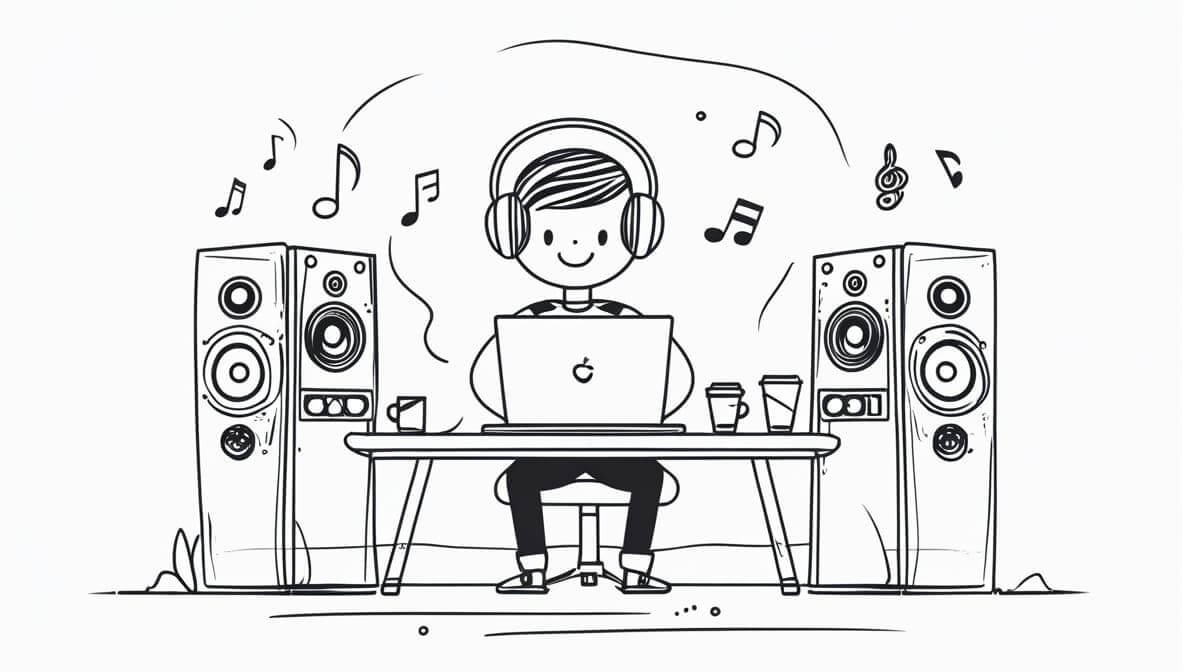Music production is an exciting and dynamic career that blends creativity with technical skills.
This guide covers key aspects such as branding as a producer, developing your sound, learning music theory, choosing the right equipment, networking, selling beats, and understanding business contracts. By following these steps, you'll build a sustainable career in music production.

In This Article
01 What Does a Music Producer Do?
A music producer — also known as a record producer — is the creative and technical mastermind behind the making of a song or album. Their primary responsibility is to oversee the entire music production process, ensuring that the final product sounds polished, cohesive, and ready for release.
Music producers play a vital role in shaping the sound and vision of a project. They may hire session musicians, select recording studios and audio engineers, manage production schedules, and coordinate workflows. During recording sessions, producers listen carefully to the performance, offer feedback, and make adjustments to improve quality and expression.
In addition to technical oversight, many music producers are deeply involved in the creative side. They might help compose songs, arrange instruments, or even contribute to songwriting and mixing. Their deep knowledge of recording equipment, musical arrangement, and industry trends enables them to bring out the best in the artists they work with.
Whether working with independent musicians or major labels, music producers are essential in turning a musical idea into a professional, commercially viable track. If you're wondering how to become a music producer, understanding these roles and responsibilities is the first step toward mastering this multifaceted career.
02 How to Become a Music Producer
01 Develop Your Musical Skills
The first step in how to become a music producer is building a solid foundation in music theory and composition. Understanding melody, harmony, and rhythm is essential to creating compelling tracks.
Start by learning to play at least one instrument — piano, guitar, or drums are excellent choices. These instruments will help you better grasp key elements of music such as chord progressions, song structure, and timing.
You don’t need to master every instrument to become a music producer, but having basic proficiency with at least one will significantly enhance your ability to compose and arrange music effectively.
Additionally, study music theory to understand how chords and scales work together. This will allow you to write better melodies and harmonies and communicate more effectively with musicians and collaborators.
| Music Theory Basics | Application in Production | How to Learn |
|---|---|---|
| Chord Progressions | Building emotional depth in tracks | Study common progressions (I-V-vi-IV) |
| Scales | Crafting melodies and basslines | Practice major, minor, and pentatonic scales |
| Rhythm & Groove | Creating engaging drum patterns | Experiment with time signatures and swing |
| Key Modulation | Enhancing musical dynamics | Learn how to transition between keys smoothly |
| Arrangement Structure | Organizing song elements | Understand intro, verse, chorus, and bridge formats |
Actionable Steps
- Play simple melodies on a MIDI keyboard to improve chord and scale familiarity
- Study chord progressions from hit songs to understand their structure
- Follow YouTube channels like Signals Music Studio or Michael New
- Experiment with different time signatures and rhythmic patterns in your DAW
LitMusic: The Perfect AI Tool for Aspiring Music Producers
If you’re learning how to become a music producer, LitMusic is your ideal creative partner. This AI-powered music generator helps you quickly experiment with beats, melodies, and arrangements—saving time and studio costs.
Whether you’re just starting or refining your production skills, LitMusic empowers you to turn ideas into polished tracks effortlessly. Harness the future of music production and elevate your sound with LitMusic today!
02 Listen Actively and Broaden Your Musical Perspective
If you're serious about learning how to become a music producer, one of the most underrated yet powerful habits is active listening. Great music producers don’t just hear music — they analyze it. They understand what makes a track work emotionally and technically.
Start by listening to a wide variety of genres — not just your personal favorites. Explore hip-hop, electronic, indie, jazz, classical, and even world music. Pay close attention to how songs are structured, how different instruments are layered, and how vocals are mixed. Focus on how each element contributes to the overall mood and impact of the track.
- Specific chord progressions and harmonies
- Distinctive rhythmic patterns
- Variations in mixing and production styles
- Unique uses of effects or instrumentation
You should also study songs that have topped the charts or gone viral. Ask yourself: Why did this track succeed? Is it the beat, the arrangement, the hook, or something else?
To sharpen your skills, dive into the work of successful music producers in the field you’re interested in. Whether it’s Rick Rubin in rock and hip-hop, Finneas in indie pop, or Metro Boomin in trap — analyze their techniques, read their interviews, and learn from their processes.
This step is crucial for finding your own voice as a producer and deciding which style of music you want to focus on developing.
03 Master Music Production Software
If you're learning how to become a music producer, mastering a Digital Audio Workstation (DAW) is essential. A DAW is your central tool for recording, editing, arranging, and mixing music — it’s to a music producer what a brush is to a painter.
Popular DAWs include Ableton Live, Logic Pro X, FL Studio, and Pro Tools. Each offers different workflows and features, so experiment with a few and choose the one that best suits your style and genre preferences.
| DAW Options | Best For | Key Features |
|---|---|---|
| FL Studio | Hip-Hop, Trap, EDM | Strong drum sequencing, excellent for sampling |
| Ableton Live | Electronic music, live performance | Powerful looping features, ideal for real-time performance |
| Logic Pro X | Pop, film scoring | Mac-exclusive, rich built-in instruments |
| Pro Tools | Recording, mixing, mastering | Industry standard for professional studios |
| Reaper / Studio One | Various genres | Lightweight, budget-friendly, highly customizable |
Essential DAW Skills
- Basic Navigation – Learn how to arrange, edit, and mix tracks efficiently
- Drum Programming – Understand beat patterns, hi-hats, 808s, and percussion placement
- Sampling Techniques – Chop, time-stretch, and manipulate samples for creative effects
- MIDI & Synthesis – Learn how to use virtual instruments and tweak synths
- Basic Mixing – Understand EQ, compression, reverb, and stereo panning
Actionable Steps
- Watch DAW tutorials on YouTube (Busy Works Beats, Andrew Huang)
- Follow structured courses on platforms like Coursera, Udemy, or Skillshare
- Create a short project daily to practice core DAW functionalities
04 Learn the Technical Side of Production
Becoming a music producer isn't just about creativity — it also requires mastering the technical side of production. This includes key skills like sound design, mixing, mastering, and arrangement. These elements shape how your music sounds and how it connects with listeners.
To stand out as a professional, you must understand how to use EQ, compression, reverb, delay, and automation effectively. Learning how to balance levels, shape tones, and build dynamic arrangements will take your tracks from amateur to industry-ready. Even if you're producing instrumentals, high-quality mixing and mastering can make the difference between a track that gets ignored and one that artists want to buy or record over.
Essential Mixing Techniques for Producers
- Export Stems Correctly – Always export 24-bit WAV stems with no mastering effects applied.
- Gain Staging – Ensure levels are balanced before adding processing.
- EQ and Frequency Balancing – Use subtractive EQ to avoid clashing instruments.
- Compression for Consistency – Apply light compression to keep dynamics controlled.
- Use Reference Tracks – Compare your mix to industry-standard tracks in a similar style.
Mastering Essentials
- Loudness Control – Use a limiter to bring up overall volume without distortion.
- Stereo Width – Use panning, stereo widening effects, and reverb for space.
- Final Check – Listen on headphones, car speakers, and phones to ensure consistency.
When to Hire a Professional Mixer
Not all producers need to master their own tracks. If you struggle with achieving a professional sound, it’s better to hire an experienced audio engineer.
Quote
“Mixing is like a car’s paint job—bad quality will turn buyers away.” – Jordan Stream
Actionable Steps
- Export all stems as 24-bit WAV files before mixing
- Use EQ, compression, and reference tracks to fine-tune your mix
- Learn basic limiting and stereo imaging for cleaner masters
- If necessary, hire a professional engineer for final mastering
05 Seek Internships, Ask for Feedback, and Keep Improving
To become a successful music producer, continuous practice, feedback, and real-world experience are essential. Many renowned producers like Metro Boomin, Kanye West, and Pharrell Williams developed their skills by creating hundreds of beats—testing, refining, and evolving their sound over time.
Landing an internship at a record label or studio can offer valuable exposure to the inner workings of the music industry. Look for opportunities at labels that align with your musical interests. Interning allows you to observe professional sessions, understand workflow, and build important connections—all while practicing your production skills without pausing your personal growth.
As you grow, focus on developing your signature sound. This doesn’t mean limiting yourself to one genre, but rather building a consistent style that artists and listeners can recognize. Experiment with VSTs like Omnisphere, Sylenth1, or Heat Up 3, and create your own transitions and effects to stand out. Most importantly, stay open to feedback and never stop learning—your sound will keep improving with every track you produce.
How to Develop Your Signature Sound
- Experiment with Virtual Instruments (VSTs): Try Sylenth, Massive, Omnisphere, and Heat Up 3 to explore different sounds.
- Create Custom Sound Effects: Avoid overused riser and downfall effects—make your own to establish originality.
- Study Successful Producers: Recreate beats from top producers like Metro Boomin, Kanye West, and Pharrell Williams to understand professional beat structure and sound selection.
Reddit user ridikolaus states: “Talent is mostly built through practice. What looks like natural ability is often just thousands of hours of learning.”
03 The 6 Stages of Music Production
Understanding the full workflow of music production is essential for any aspiring producer. Here are the six key stages every producer should know:
01 Songwriting
Songwriting involves composing the core structure of a song—its beginning, middle, and end—along with melodies, harmonies, rhythms, and optionally lyrics. Songwriters create the foundation upon which everything else is built.
02 Arrangement
Arrangement is about deciding how to organize instruments and vocals within the song. By layering sounds, harmonies, and effects over time, producers can build energy and dynamics, crafting an engaging intro, build-up, breakdown, and outro.
LitMusic: The Perfect AI Tool for Aspiring Music Producers
- AI-powered music generator perfect for aspiring music producers
- Helps you experiment with beats, melodies, and arrangements quickly
- Saves time and reduces costly studio expenses
- Great for both beginners and experienced producers to refine their skills
- Enables turning creative ideas into polished tracks effortlessly
- Embrace the future of music production with LitMusic
03 Recording
Recording is the process of capturing audio elements—vocals, instruments, and other sounds—usually tracked separately with the help of a recording engineer. This allows for detailed control during later stages.
04 Editing
During editing, the producer refines the recordings by adjusting timing, pitch, and volume levels. Crossfades and effects like EQ, reverb, or bass enhancement are added to ensure the song flows smoothly and sounds polished.
05 Mixing
Mixing involves blending all individual tracks into a cohesive stereo or surround sound output. The mix engineer balances levels, applies compression, EQ, and spatial effects to ensure clarity and impact. The producer may be closely involved or leave it to a specialist.
06 Mastering
Mastering is the final step where the mixed track is optimized for distribution. A mastering engineer adjusts overall loudness, tonal balance, and consistency—especially important for albums—to ensure the music sounds great across all playback systems.
04 Embracing AI Tools Like LitMusic on Your Journey to Becoming a Music Producer
In today’s rapidly evolving music industry, learning how to become a music producer means not only mastering traditional skills but also embracing cutting-edge technologies like AI. Tools such as LitMusic are revolutionizing music production by offering AI-powered music generation that helps producers find inspiration, experiment with new ideas, and create high-quality tracks without the high costs of studio time.
AI music generators like LitMusic enable producers to quickly generate instrumentals, explore different arrangements, and even draft song ideas, significantly accelerating the creative process. For aspiring and professional producers alike, these tools are invaluable for overcoming creative blocks and refining your unique sound.
However, to truly harness the power of AI, a solid foundation in music theory and production techniques is essential. Producers with professional knowledge can better guide AI tools to produce customized, polished results that align with their artistic vision.
Ready to take advantage of AI-driven music production? Try LitMusic for free today and start creating your own tracks with ease and innovation.
Bonus: Choosing the Right Equipment & Setting Up Your Home Studio
You don’t need a fancy studio to begin your journey as a music producer, but building a basic home setup can make a huge difference. With just a modest investment, you can create a space where you can experiment, learn, and grow your production skills.
Essential Equipment for Music Production
| Category | Recommended Options |
|---|---|
| DAW (Digital Audio Workstation) | FL Studio, Ableton Live, Logic Pro |
| Headphones | Audio-Technica ATH-M50X, Beyerdynamic DT 770 |
| MIDI Keyboard | Akai MPK Mini, Arturia KeyLab |
| Audio Interface | Focusrite Scarlett 2i2, Universal Audio Volt |
Software & Plugins
- Free DAWs: Try Cakewalk or Reaper before upgrading.
- Essential Plugins: Invest in Serum, Omnisphere, Waves Bundle for high-quality sound design.
Quote
“Forget fancy equipment—master your DAW first,” says Reddit user Actually-Yo-Momma.
Actionable Steps
- Start with free plugins before purchasing premium ones
- Organize drum kits and preset libraries to improve workflow
- Research which plugins complement your production style
And if you're looking to speed up your workflow, AI tools like LitMusic are a game-changer. Whether you want to brainstorm new melodies, test arrangement ideas, or save time and studio costs, LitMusic empowers producers to go from concept to creation with ease. Use it as a creative partner to unlock your full potential.
As your skills progress, you can slowly upgrade your space with studio monitors and acoustic treatment to enhance sound accuracy and take your production to the next level.
Final Thoughts
Becoming a successful music producer requires branding, technical skills, networking, and business knowledge. With structured learning and consistent effort, you can turn music production into a full-time career. Keep creating, stay consistent, and never stop learning!
LitMusic: The Perfect AI Tool for Aspiring Music Producers
Ready to put everything you’ve learned into action? LitMusic is the all-in-one platform built for serious music producers—just like you.
- AI-powered music generator perfect for aspiring music producers
- Helps you experiment with beats, melodies, and arrangements quickly
- Saves time and reduces costly studio expenses
- Great for both beginners and experienced producers to refine their skills
- Enables turning creative ideas into polished tracks effortlessly
- Embrace the future of music production with LitMusic


















